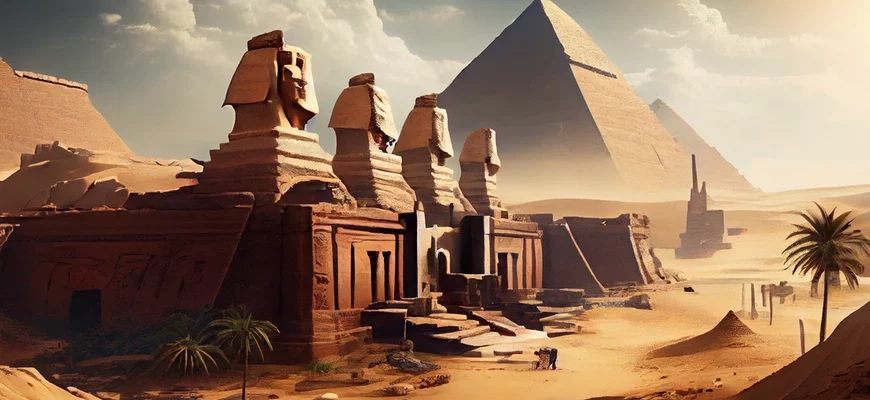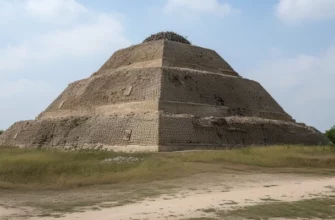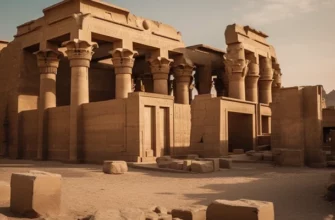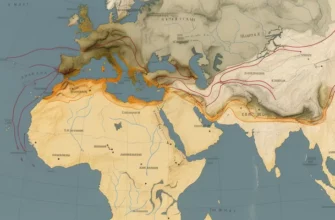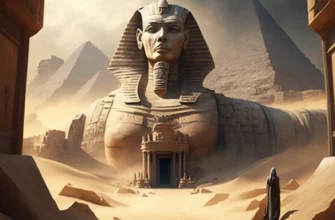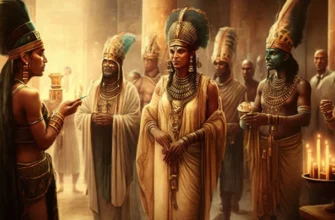The Old Kingdom of Egypt is a period in the history of Ancient Egypt that spans from approximately 2686 to 2181 BC. This period is characterized by magnificent pyramids, the rise of the pharaohs, and the development of the economy and culture. In this article, we will examine the history, culture, economy, and society of the Old Kingdom of Egypt, as well as the causes and consequences of its decline.
It was a period of great stability and prosperity, when power was concentrated in the hands of the pharaohs, who had a significant influence on the economy, culture, and religion. One of the most notable features of the Old Kingdom of Egypt is the construction of the magnificent pyramids, which were built as tombs for the pharaohs.
- The emergence of the Old Kingdom of Egypt
- Development of the state
- Protection from enemies
- Culture
- Art and architecture
- Religion and gods
- Cultural achievements
- Economy and society
- Agriculture
- Trade and crafts
- Social structure and daily life
- The Fall of the Ancient Kingdom of Egypt
- Reasons for the fall
- Consequences for Ancient Egypt
- Conclusion
The emergence of the Old Kingdom of Egypt
The emergence of Ancient Egypt dates back to the beginning of the 3rd millennium BC. This was a period of unification of Upper and Lower Egypt into a single state ruled by the pharaohs. During this period, stability and order were established, which contributed to the development of culture, science, and religion. The power of the pharaohs was unshakable, which allowed them to carry out large-scale construction projects, such as the magnificent pyramids, which became a symbol of the Ancient Kingdom of Egypt.
Development of the state
The development of the Ancient Kingdom of Egypt took place between approximately 2686 and 2181 BC. During this period, power was concentrated in the hands of the pharaohs, who were not only political and military leaders but also a kind of deity. The economy developed through the collection of taxes, various reforms, and the creation of new crafts. Culture also developed, writing was created, theaters and temples were founded, and the construction of the magnificent pyramids, which became the symbol of the Ancient Kingdom of Egypt, began.
Protection from enemies
The Ancient Kingdom of Egypt maintained its independence and territorial integrity for a long time thanks to its military potential. The country’s army had various types of troops, such as infantry, cavalry, and archers. In addition, special units were created to protect the borders from enemy attacks. Another important component of defense was defensive structures, such as fortresses and walls, which protected settlements and roads. The pharaohs also used diplomacy and favorable treaties with neighboring states to maintain peace and independence.
Culture
The culture of the Ancient Kingdom of Egypt was highly developed and diverse. Considerable attention was paid to religion, which played an important role in the life of the people. A large number of religious buildings were constructed, such as temples, shrines, and pyramids, which not only had religious significance but also served as burial places for pharaohs and other prominent figures.
The culture of Ancient Egypt also included art, architecture, literature, and music. A large number of various works of art were created, such as sculptures, paintings, reliefs, and others. The first literary works, including songs and poems, were created during this period. In addition, a writing system was developed, which ensured the preservation of information about this period of Egyptian history.
Art and architecture
The art and architecture of Ancient Egypt reflected the rich culture and religious beliefs of the people. Sculptures and reliefs were used to depict gods, pharaohs, and other important figures. Temples and other religious buildings were decorated with these works of art.
The architecture of Ancient Egypt included buildings of various shapes and sizes, such as pyramids, temples, palaces, and fortresses. The most famous of these are the majestic pyramids, in particular the Pyramid of Cheops, which is one of the Seven Wonders of the World. Each pyramid was built as a tomb for the pharaoh and his relatives and was an object of religious worship. The architecture of Ancient Egypt is impressive for its monumentality and meticulous execution.
Religion and gods
Religion was an extremely important part of the life of the people of Ancient Egypt. They believed in many gods, each of which played a role in the cosmos and human life. The main gods – Ra, Osiris, Isis, Horus, and Anubis – were represented in art and architecture.
Hieroglyphic writing was practiced in Ancient Egypt and was used to write sacred texts that described religious and mythological stories. Most people in Ancient Egypt believed in the afterlife and mummified their dead to preserve their bodies for the future life after death. Religion was extremely important in Ancient Egyptian culture and influenced all aspects of people’s lives, including art, architecture, and science.
Cultural achievements
Ancient Egypt was renowned for its significant cultural achievements, including architecture, art, literature, and science. Egyptian architects built enormous pyramids, temples, and obelisks, which have survived for tens of thousands of years as evidence of the flourishing ancient civilization. Ancient Egyptian art utilized a wide range of materials, including wood, stone, metals, and glass. Their art was often related to religious themes, such as depictions of gods or stories of the lives of the deceased. Ancient Egyptian literature produced famous texts such as the Book of the Dead, which contained instructions and prayers related to death and the afterlife. Science also developed in Ancient Egypt; for example, the ancient Egyptians had highly developed knowledge in the fields of mathematics and astronomy.
Economy and society
The economy of Ancient Egypt was based on agriculture and trade. The Egyptians used an irrigation system to make the deserts suitable for agriculture. Society was organized according to the feudal system, where the pharaoh was the supreme ruler of the country. The upper class consisted of pharaohs, priests, and nobles, while the lower class consisted of peasants and artisans. Ancient Egypt had a developed writing system that allowed the country to be governed and records of events and trade to be kept. The country also had a developed trade flow that provided for their needs in various materials and goods from other countries.
Agriculture
Agriculture was the basis of the economy of Ancient Egypt. The Egyptian pharaohs created an irrigation system that made the deserts suitable for agriculture. With this irrigation system, they ensured an even distribution of water for plant growth. Yields depended on the water level in the Nile, so the pharaohs regulated this level using a system of floodplains that allowed water to be stored in the river. The main crops grown in Ancient Egypt were wheat, barley, soybeans, vegetables, and fruits such as grapes and dates. Agricultural products were used to produce bread, beer, and other foods.
Trade and crafts
Trade was an important component of the economy of Ancient Egypt. The country had a strategic location between the Mediterranean and Red Seas, which provided access to trade with countries in the East and West. Egypt traded its agricultural and craft products, such as linen cloth, jewelry, glass, ceramics, metalwork, and other items, with countries located along the shores of the Mediterranean and Red Seas. Crafts such as pottery, blacksmithing, weaving, and others also developed in Ancient Egypt. They were necessary to meet the needs of the population, produce items for trade and export, and create building materials.
Social structure and daily life
The social structure of Ancient Egypt was hierarchical and divided into several strata. At the top were the pharaohs, who were considered divine and superhuman. Below them were sovereign and district leaders, priests, aristocrats, craftsmen, and peasants. A person’s social status was determined by their profession and membership in a particular class.
Daily life in Ancient Egypt was closely linked to religion and culture. Many people worked on agricultural land, growing bread and vegetables, and producing fabrics and handicrafts. People also engaged in fishing and cattle breeding.
Daily life was limited by traditions and religious rituals. People believed in life after death and performed complex mummification procedures to preserve their bodies for the afterlife. In their free time, people played games such as “senet” and “meisen,” listened to music, and danced.
The Fall of the Ancient Kingdom of Egypt
The Ancient Egyptian Kingdom ceased to exist after a period of crisis and the rise to power of individual regional princes. This led to the fragmentation of the country into independent regions. This period also saw the migration of peoples from Eastern Europe and Western Asia, which may have been one of the reasons for the collapse of the state.
In addition, natural disasters such as severe floods and earthquakes led to the destruction of some monuments and a decrease in land productivity. Attacks by neighboring states, such as the Nubians and Amorites, also intensified during this period.
As a result, the Ancient Egyptian kingdom experienced significant difficulties that led to its collapse and the restoration of power only after the Middle Kingdom period.
Reasons for the fall
The fall of the Ancient Egyptian kingdom was caused by a combination of various factors. One of the main factors was the decline in land productivity and natural disasters such as floods and earthquakes, which led to a decline in production and the destruction of cities.
Another reason was conflicts and wars with neighboring peoples such as the Nubians and Amorites. These conflicts led to the loss of territory and a decline in influence on the international stage.
Internal political instability and conflicts between different factions of power also played a significant role in the fall of the state. These conflicts led to the decline of the power system and an increase in the regional influence of individual princes and chiefs.
Finally, the migration of peoples from Eastern Europe and Western Asia may be another reason for the fall of the Ancient Egyptian Empire. The large number of newcomers changed the demographic composition of the country and may have led to a decline in economic potential and political influence.
Consequences for Ancient Egypt
The fall of the Ancient Kingdom of Egypt led to a crisis, a decline in the role of the pharaohs, and an increase in the influence of local princes. A small feudal system emerged, leading to competition between cities and regions. The result was a decline in cultural standards, a deterioration in the lives of the population, an increase in crime, and general chaos. The fall of the Old Kingdom also led to the creation of the New Kingdom of Egypt, which deprived the country of political and cultural unity for decades.
Conclusion
Ancient (Old) Kingdom of Egypt (c. 2686-2181 BC) is of great importance to the present day for several reasons:
Cultural heritage: The ancient Egyptians left us a wealth of architectural masterpieces, art, music, poetry, literature, and other forms of culture that have become an integral part of world culture.
Science and technology: The ancient Egyptians were known for their achievements in mathematics, astronomy, medicine, and other sciences. They are also known for their inventions, such as papyrus, water clocks, pyramids, and other buildings.
Religion: The religion of the ancient Egyptians is important to modern researchers because it became the prototype for many of the world’s religions, including Christianity and Islam.
History: Egypt has a long and rich history, including periods when Egypt was the most powerful state in the world. Its history and culture have left a deep mark on world history, allowing us to better understand the past and helping us to make more accurate conclusions about how the modern world is developing.
Thus, the ancient kingdom of Egypt is significant for the present day as a cultural, scientific, religious, and historical heritage. Studying Egypt helps to expand our knowledge of the world and understand it better.
